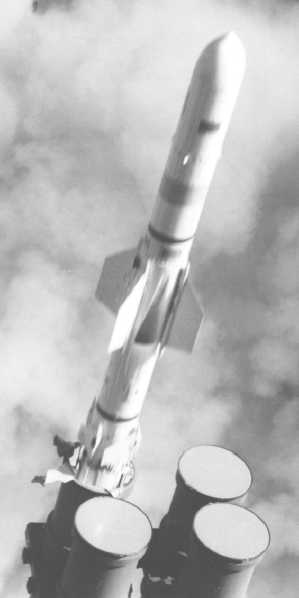| |
Characteristics of the SM-2(ER) missiles:
Length:
26 feet, 2 inches
Diameter:
13.5 inches
Wing span:
5 feet, 2 inches
Weight:
2,980 pounds
Range:
More than 30 nautical miles
SPARROW
The AIM/RIM-74 is a much-improved and
highly successful air-to-air and surface-to-air
version of the Sparrow missile. It has considerably
greater invulnerability to electronic counter-
measures (ECM) and better target-tracking
capability. The fifth operational missile of the
Sparrow family, it can be employed against
attacking aircraft at all tactical speeds and
altitudes in all weather. With folding wings and
clipped tail fins, it is compatible with the North
Atlantic Treaty Organization (NATO) Sea Sparrow
launcher. Entering the Navy’s inventory in 1983,
this latest version of the Sparrow family continues
to be one of the Navy’s most heavily procured
missiles.
Characteristics of the Sparrow:
Length:
12 feet
Diameter:
8 inches
Wing span:
3 feet, 4 inches
Weight:
510 pounds
Speed:
More than 2,660 miles per hour
Range:
More than 30 nautical miles
CRUISE MISSILES
Since World War II the U.S. Navy has relied
upon carrier aircraft to maintain sea control.
Other navies, not having the money for carriers,
developed antiship missiles. These missiles were
first used successfully by the Egyptians to sink the
Israeli destroyer Elath in 1967. The battle opened
a new era in naval warfare. Any nation with a
relatively modest investment could successfully
challenge the most powerful naval forces.
The United States did not start development of
a similar weapon until 1971. At that time the
United States realized our Navy did not have the
benefit of an equal weapon against ships equipped
with antiship missiles. This led to the development
of the Harpoon cruise missile. Further research
eventually led to the development of the
Tomahawk cruise missile.
HARPOON
The Harpoon (fig. 20-3) is a medium-range,
rocket-boosted, turbo-sustained, antiship cruise
134.53
Figure 20-3.-Harpoon missile being launched
from a canister launcher aboard USS Leahy
(CG-16).
20-5
|

